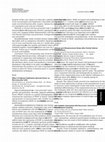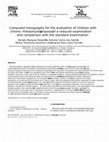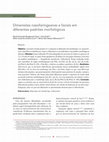Papers by Wilma Anselmo-lima
International Journal of Pediatric Otorhinolaryngology, 2005

International Journal of Pediatric Otorhinolaryngology, 2003
Hypertrophy of the adenoids and palatine tonsils is the second most frequent cause of upper respi... more Hypertrophy of the adenoids and palatine tonsils is the second most frequent cause of upper respiratory obstruction and, consequently, mouth breathing in children. Prolonged mouth breathing leads to muscular and postural alterations which, in turn, cause dentoskeletal changes. The aim of this study was to determine muscular, functional and dentoskeletal alterations in children aged 3-6 years. Seventy-three children, including 44 with tonsil hypertrophy and 29 controls, were submitted to otorhinolaryngologic, speech pathologic and orthodontic assessment. Otorhinolaryngologic evaluation revealed a higher incidence of nasal obstruction, snoring, mouth breathing, apneas, nocturnal hypersalivation, itchy nose, repeated tonsillitis and bruxism in children with tonsils hypertrophy. Speech pathologic assessment showed a higher incidence of open lip and lower tongue position, and of hypotonia of the upper and lower lips, tongue and buccinator muscle in these children, accompanied by important impairment in mastication and deglutition. Orthodontic evaluation demonstrated a higher incidence of lower mandible position in relation to the cranial base, a reduction in lower posterior facial height, transverse atresia of the palate, and a dolicofacial pattern. Postural and functional alterations anticipate dentoskeletal changes, except for the facial pattern. Postural alterations and the skeletal pattern seem to play an important role in infant dentofacial growth.
Objectives: To evaluate the dynamic behavior of inferior turbinates in children by acoustic rhino... more Objectives: To evaluate the dynamic behavior of inferior turbinates in children by acoustic rhinometry.Methods: Sixteen patients had been evaluated, aged 2 to 11 years old (mean, 9.25), 9 female (56.25%) and 7 male (43.75%) volunteers between April and July 2003. The patients were submitted to acoustic rhinometry for 3 hours, 30 minutes each.Results: All evaluated children had presence of nasal

Brazilian journal of otorhinolaryngology
We report clinical and histological results obtained after partial inferior turbinectomy (PIT), s... more We report clinical and histological results obtained after partial inferior turbinectomy (PIT), surgery indicated for the treatment of chronic nasal obstruction. Twenty patients were divided into two groups submitted to PIT plus septoplasty and PIT alone. The patients were reassessed clinically and histologically by means of a biopsy of the regenerated areas in the inferior turbinates at two different times after PIT, i.e., after 8 to 12 months (group A) and after two years (group B). The clinical results proved to be satisfactory for the relief of nasal obstruction in group A and unsatisfactory in group B. However, better histological results with better recovery and epithelial differentiation of the regenerated mucosa of the inferior turbinates after PIT were observed in group B. Surgery proved to be effective on a short-term but not on a long-term basis, and histological recovery did not accompany improvement of clinical signs and symptoms.

International journal of pediatric otorhinolaryngology, 2004
Nasal obstruction is a common symptom in children and its etiology includes septal deviation, cho... more Nasal obstruction is a common symptom in children and its etiology includes septal deviation, choanal atresia, allergic rhinitis and hypertrophy of the adenoids. Hypertrophy of the adenoids and hypertrophic rhinitis are the most frequent causes of nasal obstruction in the pediatric population, with adenoidectomy being the main surgery carried out during childhood. To analyze the rhinograms of children with nasal obstruction before and after surgery and to compare them with those obtained for children without respiratory complaints. A clinical prospective study. Thirty-five patients with adenoid or adenotonsillar hypertrophy were submitted to otolaryngologic examination and acoustic rhinometry before and 30-60 days after surgery. The control group consisted of 18 children without nasal complaints. Significant differences in the rhinograms were observed before and after surgery, but not between patients and the control group. We conclude that acoustic rhinometry is well tolerated by c...

American Journal of Rhinology & Allergy, 2006
Studies concerning nasal cycle physiology in children are still rare, and controversies exist abo... more Studies concerning nasal cycle physiology in children are still rare, and controversies exist about its existence. This study was ascertained to evaluate the dynamic behavior of inferior turbinates in children by acoustic rhinometry. Sixteen volunteer patients, aged 2-11 years old (mean, 6.25 years), were evaluated between April and July 2003. The patients submitted to periodic acoustic rhinometry, with triplicate measurements (each 30 minutes) for 3 hours. All evaluated children presented nasal cycles, with five children presenting a classic pattern (31.25%), three children presenting a concert pattern (18.75%), and eight children presenting an irregular pattern (50%). This study suggests that children present nasal cycles, as well as adults. Nevertheless, the most prevalent pattern in children was the irregular pattern, whereas in adults the most frequently detected is the classic pattern.

International Journal of Pediatric Otorhinolaryngology, 2006
Objectives: To evaluate the myofunctional status in children submitted to adenoidectomy or adenot... more Objectives: To evaluate the myofunctional status in children submitted to adenoidectomy or adenotonsillectomy, correlating the pre and post-surgical patterns throughout a 24-month-period. To correlate the myofunctional alterations to the sort of surgery performed (adenoidectomy versus adenotonsillectomy) and to the predominant post-surgical breathing pattern (predominantly nasal versus allergic rhinitis). Methods: Forty children were assessed by the otorhinolaryngologist and speech therapist before and 1-24 months after surgery. In order to evaluate myofunctional status, a pre-structured protocol was designed, which included observations regarding facial posture, tonicity, mastication, deglutition and respiration. A score from 0 (normal pattern) to 12 (highly altered) was set. Results: There was a partial, but progressive decrease of the score after surgery ( p < 0.001). This decrease was markedly observed during the first 6 months following surgical procedure ( p < 0.001), after which it was no longer significant. There was no correlation between the myofunctional progress and the sort of surgery performed. The myofunctional improvement was more accentuated in nasal breathers when compared to those with allergic rhinitis. Conclusions: Improvement of myofunctional status seems to be observed in children after surgery. In this study, the improvement was predominantly accomplished during the first 6 months following surgical procedure. Persistent pattern of mouth breathing due to allergic rhinitis may difficult recovery of the myofunctional status. The most adequate post-surgical moment for the otorhinolaryngologist to refer the patient to §
Abusive vocal habits such as shouting, speaking too much with strong intensity or with much effor... more Abusive vocal habits such as shouting, speaking too much with strong intensity or with much effort and laughing loud represent 39.6%. The favorite play of 55.3% of the children involved the use of voice and 24.2% imitated other voices. We confirmed that 33.3% of the parents considered the child's voice as being altered, and out of whom, 27.3% ranked it
Otolaryngology-head and Neck Surgery, 2004
Objectives: In chronic rhinosinusitis (CR), the mucosa inflammation leads to qualitative and quan... more Objectives: In chronic rhinosinusitis (CR), the mucosa inflammation leads to qualitative and quantitative alterations in the respiratory epithelium, which lies over the whole nasal and sinus cavities, leading to the maintenance of the inflammatory process. The main goal of this study was to describe the main histological and ultra-structural alterations in the uncinate process (UP) mucosaMethods: Twelve patients with chronic
Revista Brasileira de Otorrinolaringologia, 2003
Palavras-chave: polipose, doença inflamatória crônica, alterações ultraestruturais. ... INTRODUCT... more Palavras-chave: polipose, doença inflamatória crônica, alterações ultraestruturais. ... INTRODUCTION: Nasosinusal polyposis is a degenerative disease of the mucosa with the formation of multiple polypoid structures in the nasal cavities and facial sinuses whose ...

International Journal of Pediatric Otorhinolaryngology, 2000
Rhinosinusitis is a disease that has attracted increasing attention both in terms of triggering f... more Rhinosinusitis is a disease that has attracted increasing attention both in terms of triggering factors and of treatment evolution, with its possible complications and repercussions. Follow-up of chronic cases almost always requires imaging evaluation and computed tomography (CT) has been considered the &amp;amp;#39;gold standard&amp;amp;#39; for these cases, for which the exam must often be repeated more than once. This fact implies submitting the patient to a greater radiation load and, in the case of some children, to repeated sedation, causing possible damage to the patient, concern to the parents and to the physician when he requests this procedure. In the present study, the authors propose a reduced CT technique compared to the standard exam, with a smaller number of slices, to be used for the initial evaluation of a case and for the follow-up of chronic cases, with the standard examination reserved for cases requiring the best possible anatomical detailing, such as surgical cases. The standard technique involves 2-mm thick sections spaced 5 mm apart. In the reduced technique, the spacing is 10 mm, with a consequent reduction in the number of sections. Twenty-one children aged 4-13 years were submitted for the examination. The advantages of the proposed method reside in the reduction of the radiation load to which the patient is exposed, in its better agility, with a reduced time of execution and a consequent increase in collaboration on the part of the child, and in the reduction on cost of the procedure. It is also a technique of easy execution that does not require specific technical training.

Dental Press Journal of Orthodontics, 2010
Objetivo: o presente estudo propõe-se a comparar as dimensões da nasofaringe e as características... more Objetivo: o presente estudo propõe-se a comparar as dimensões da nasofaringe e as características esqueléticas avaliadas por exame cefalométrico, em indivíduos com padrões morfológicos distintos. Métodos: foram utilizadas 90 telerradiografias de pacientes de ambos os gêneros, de 12 a 16 anos de idade, as quais foram igualmente divididas em três grupos distintos, referentes aos padrões morfológicos -braquifacial, mesofacial e dolicofacial. Foram realizadas medições específicas da região nasofaringeana (ad 1 -Ptm, ad 2 -Ptm, ad 1 -Ba, ad 2 -S 0 , (ad 1 -ad 2 -S 0 -Baad 1 /Ptm-S 0 -Ba-Ptm) X 100, e Ptm-Ba) e relativas ao padrão esquelético da face. Resultados: observou-se que os pacientes dolicofaciais apresentaram menor profundidade sagital óssea (Ptm-Ba) e da via aérea da nasofaringe (ad 1 -Ptm e ad 2 -Ptm). Sugere-se que essas diferenças estejam relacionadas a um posicionamento relativamente mais posterior da maxila, comum a esses pacientes. Todavia, não foram detectadas diferenças quanto à espessura de tecido mole na parede posterior nasofaringeana (ad 1 -Ba e ad 2 -S 0 ), ou à sua proporção em relação a toda a área delimitada para a nasofaringe [(ad 1 -ad 2 -S 0 -Ba-ad 1 /Ptm-S 0 -Ba-Ptm) X 100]. Conclusão: sugere-se, portanto, que as características faciais de excesso vertical encontradas em pacientes dolicofaciais podem ocorrer, dentre outros fatores, em virtude da obstrução da via aérea nasofaringeana, uma vez que tais dimensões se apresentaram menores para os dolicofaciais.
The recognition of sessile form of bacteria with particular features, known as biofilm, has given... more The recognition of sessile form of bacteria with particular features, known as biofilm, has given new insights to the understanding of pathogenesis of several chronic diseases, including Chronic Rhinosinusitis (CRS). In this article we review the main characteristics of biofilms, describe the current methods used to demonstrate biofilms in chronic rhinosinusitis and discuss the future directions of research in the field.
Revista Brasileira de Otorrinolaringologia, 2007
Base de dados : LILACS. Pesquisa : 470451 [Identificador único]. Referências encontradas : 1 [ref... more Base de dados : LILACS. Pesquisa : 470451 [Identificador único]. Referências encontradas : 1 [refinar]. Mostrando: 1 .. 1 no formato [Detalhado]. página 1 de 1, 1 / 1, LILACS, seleciona. para imprimir. Fotocópia. Texto completo SciELO Brasil (texto : PT). ...
Revista Brasileira de Otorrinolaringologia, 2008
Revista BRasileiRa de OtORRinOlaRingOlOgia 74 (2) MaRçO/aBRil 2008 http://www.rborl.org .br / e-m... more Revista BRasileiRa de OtORRinOlaRingOlOgia 74 (2) MaRçO/aBRil 2008 http://www.rborl.org .br / e-mail: revista@aborlccf.org.br ... Estudo de coorte contemporânea com corte transversal. ... As diferenças histológicas dos pólipos nasais ea sua possível implicação ...
International Journal of Pediatric Otorhinolaryngology, 2011

International Journal of Pediatric Otorhinolaryngology, 2006
Introduction: Atresia of the maxilla is a transverse skeletal dysplasia, possibly associated with... more Introduction: Atresia of the maxilla is a transverse skeletal dysplasia, possibly associated with respiratory problems. For its correction, rapid maxillary expansion is a feasible orthodontic process. Objective: To evaluate the effect of rapid maxillary expansion on the nasal cavity by acoustic rhinometry and computed rhinomanometry. Material and methods: Twenty-nine children of both sexes with oral and/or mixed breathing, ranging in age from 7 to 10 years and with mixed dentition were selected. The children had uni-or bilateral posterior crossbite involving deciduous canines and the first permanent molars and were not being submitted to any otorhinolaryngologic or orthodontic treatment. All subjects were submitted to rhinologic exams and orthodontic documentation at three different times, i.e., before expansion and immediately and 90 days after expansion. Results: There was no difference in the minimal cross-sectional area at the level of the valve and inferior nasal turbinate between the periods analyzed, but there was a statistically significant reduction in nasal resistance after expansion.
Revista Brasileira de Otorrinolaringologia, 2004
Revista Brasileira de Otorrinolaringologia, 2004
1 Pós-Graduandos, Nível Mestrado do Departamento de Oftalmologia, Otorrinolaringologia e Cirurgia... more 1 Pós-Graduandos, Nível Mestrado do Departamento de Oftalmologia, Otorrinolaringologia e Cirurgia de Cabeça e Pescoço da FMRP-USP. 2 Técnica do Laboratório de Microscopia Eletrônica do Biologia Celular e Molecular e Bioagentes Patogênicos. 3 Professor Doutor do ...
Brazilian Journal of Otorhinolaryngology, 2015

Uploads
Papers by Wilma Anselmo-lima